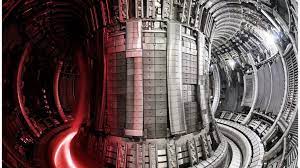
According to a poll released on Wednesday, companies hoping to harness the mechanism that drives the sun and stars to generate electricity expect to invest around $7 billion by the time their first nuclear fusion facilities come online.
When the nuclei of two light atoms, such as hydrogen, are heated to tremendous temperatures, they fuse into one heavier nucleus, releasing enormous amounts of energy.
According to the Fusion Industry Association (FIA) report, commercial enterprises and government labs spent $500 million on their supply chains last year in order to master the fusion process utilising lasers or magnets.
According to a poll of roughly two dozen developers, spending on fusion is expected to skyrocket to $7 billion by the time fusion companies build their first power plant, and perhaps trillions of dollars in a mature fusion industry, which is expected to emerge between 2035 and 2050.
Much of the supply chain expense is projected to go towards high-grade steel, concrete, and superconducting wire for the construction of plants where fuels will be heated to more than 100 million degrees Celsius in specific chambers. Super magnets, lasers, and power supply will also be funded.
According to Andrew Holland, the head of FIA, there is little concern about geopolitical supply risk in the supply chain because no vital parts or materials suffer global supply constraints or are sourced solely from politically unstable xcoutnries.
"The biggest challenge honestly is just scale," Holland said. "We want to make sure the supply chain companies are aware that fusion is coming so they can make the investments to scale up."
While there is a global shortage of tritium, a fuel that many firms intend to utilise to power fusion plants, Holland claims that this is not a problem because the companies intend to breed tritium in the fusion plants using lithium.
He projected that a fusion plant would only require the amount of lithium present in four electric automobiles.
(Source:www.reuters.com)
When the nuclei of two light atoms, such as hydrogen, are heated to tremendous temperatures, they fuse into one heavier nucleus, releasing enormous amounts of energy.
According to the Fusion Industry Association (FIA) report, commercial enterprises and government labs spent $500 million on their supply chains last year in order to master the fusion process utilising lasers or magnets.
According to a poll of roughly two dozen developers, spending on fusion is expected to skyrocket to $7 billion by the time fusion companies build their first power plant, and perhaps trillions of dollars in a mature fusion industry, which is expected to emerge between 2035 and 2050.
Much of the supply chain expense is projected to go towards high-grade steel, concrete, and superconducting wire for the construction of plants where fuels will be heated to more than 100 million degrees Celsius in specific chambers. Super magnets, lasers, and power supply will also be funded.
According to Andrew Holland, the head of FIA, there is little concern about geopolitical supply risk in the supply chain because no vital parts or materials suffer global supply constraints or are sourced solely from politically unstable xcoutnries.
"The biggest challenge honestly is just scale," Holland said. "We want to make sure the supply chain companies are aware that fusion is coming so they can make the investments to scale up."
While there is a global shortage of tritium, a fuel that many firms intend to utilise to power fusion plants, Holland claims that this is not a problem because the companies intend to breed tritium in the fusion plants using lithium.
He projected that a fusion plant would only require the amount of lithium present in four electric automobiles.
(Source:www.reuters.com)





